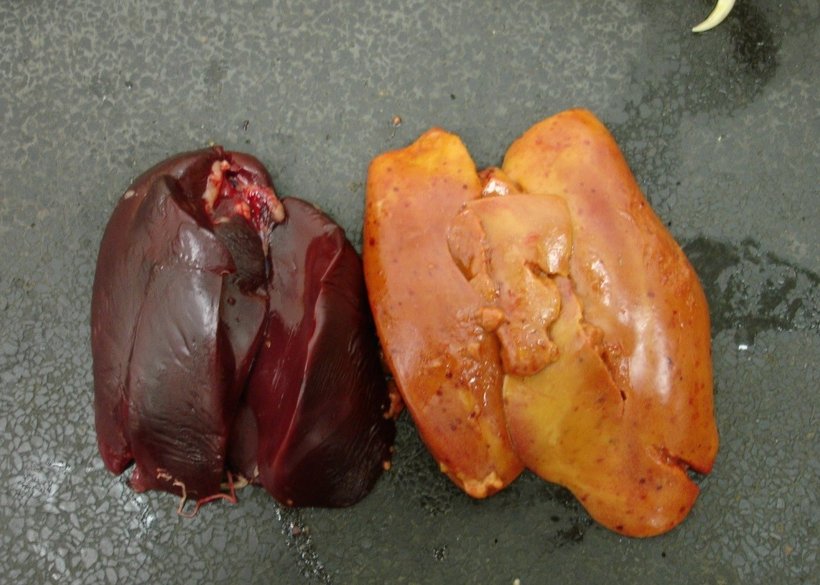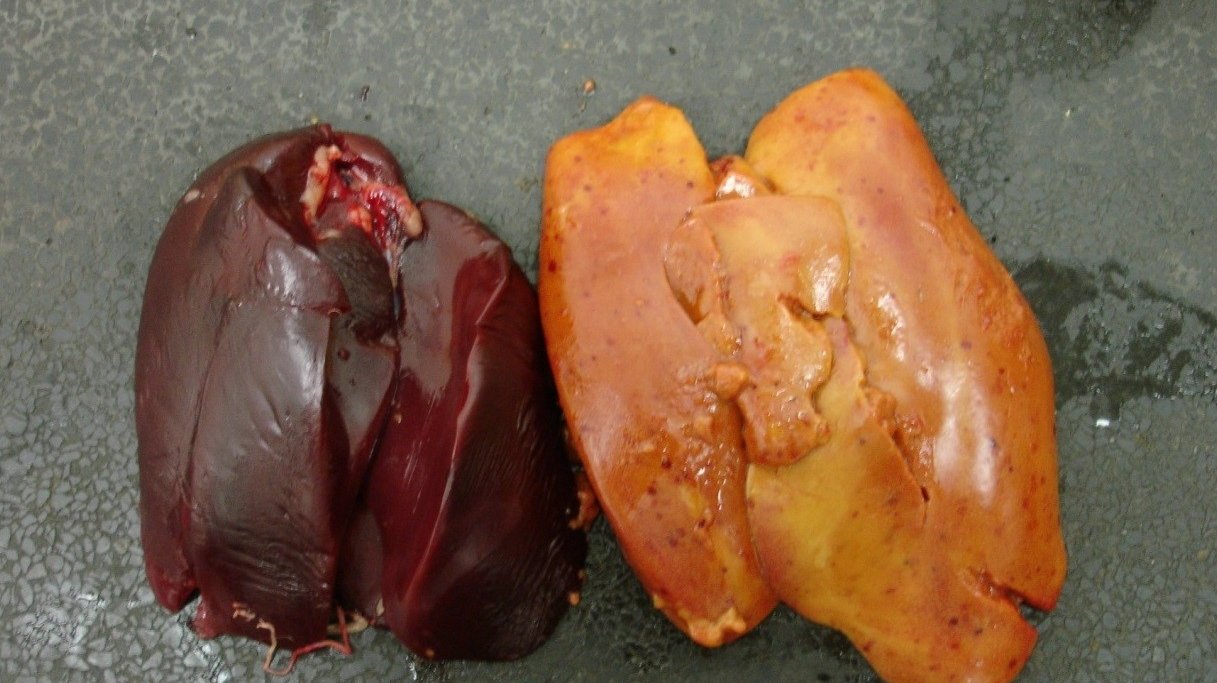
Published on March 4, 2020
The importance of a healthy liver
Liver condition is extremely important for excellent egg production, as the egg yolk is produced by the liver. A healthy liver is linked with a high egg production capacity. The liver is involved in the activation of vitamin D3 and hence affects the calcium metabolism and on the quality of the eggshells. In this article on the importance of a healthy liver, we would like to explain the predisposing factors of a fatty liver, and how to prevent your birds from developing fatty livers.
The liver is a key organ
The liver is a large and important organ, which has essential functions in nutrient utilization. The liver is involved in the metabolism of fat, proteins and carbohydrates. Furthermore, it can store several fat soluble vitamins, such as vitamin A, D, E and K, several water soluble vitamins (B1, B2 and B12) and minerals (Fe and Cu). Next to this, the liver is also involved in activating vitamin D3 to stimulate calcium absorption for eggshell formation. Besides, the liver is important for converting toxins into water-soluble waste products which can be excreted via the kidneys.
The liver can convert glucose into glycogen and triglycerides, which are stored as energy during higher blood glucose levels. Controversy, it can break down glycogen to be used as glucose when low blood glucose levels occur. The liver can convert fats and amino acids into glucose as well. Catabolizing protein requires quite some energy and therefore results in a higher heat increment compared to the use of fat or carbohydrates for energy. Fat is digested to fatty acids and absorbed in the intestines, most of the fatty acids enter directly in the blood system and consequently they reach the liver. The liver can store or metabolize those fatty acids. Fat synthesis for yolk lipoproteins is an important process in the liver. When fat synthesis is faster than the mobilization of fat, the accumulation of lipids in the liver starts. When occurring for a longer time, it is called hepatic steatosis, or better known as fatty liver.
The severity of a fatty liver is increasing as the laying hens get older, as more egg yolk and so egg mass has been produced. At an age of 100 weeks, a laying hen is able to produce over 30 kg of egg mass. This equals over 17 times her own body weight!
Fatty liver
The state of hepatic steatosis, or fatty liver, reflects the accumulation of lipids in the liver. Consequently, liver cells are reducing in efficiency, and they might even be destroyed and replaced by connective tissue. It is a non-infectious metabolic disorder, resulting in liver rupture, hemorrhage, reduced egg production, increased FCR, reduced eggshell quality, internal bleeding and higher mortality rates. Fatty livers are often seen in laying hens that are fed with layer diets with an imbalance between energy and protein. The excess of energy intake whilst limited activity contributes to the development of fatty livers.

Figure 1 A healthy liver (left) versus a fatty liver (right)
Egg shell quality and fatty liver
As mentioned above, the liver has several important functions. One of those functions is activating vitamin D3 (Cholcalciferol) to 25-hydroxy-vitamin D (25-OH-D3 or Calcidiol). 25-hydroxy-vitamin D3 is transferred to the kidneys for the last activation step towards 1,25 dihydroxy-vitamin D (1,25-(OH)2D3 or Calcitriol. The vitamin D3 metabolite Calcitriol stimulates calcium absorption for eggshell formation. Laying hens, that have a fatty liver, often produce eggshells with a poorer eggshell quality.
Predisposing factors of a fatty liver
Fatty liver is a disease caused by numerous factors that are affecting the fat utilization from the liver. The main factor is a positive energy balance of the birds. The energy balance is affected by the birds’ environment, hormones and nutritional factors.
Environment
The environment, like type of housing and housing conditions, affect the energy requirement and so energy balance of the birds. Laying hens can develop a fatty liver in all kinds of housing systems, but laying hens kept in alternative housing systems are more active and are therefore less likely to develop a fatty liver, compared to laying hens housed in (enriched) cages.
High environmental temperature, like summer periods, reduce the energy requirement for the birds’ maintenance, due to less activity and less need to produce heat to maintain the birds’ body temperature. Furthermore, heat stress affects the metabolism of fat. With a reduced energy requirement, a positive energy balance is more likely and therefore birds that are housed under higher environmental temperature conditions have a higher chance to develop a fatty liver.
Stress can be caused by temperature stress, vaccination stress, or stress from management. Stress increases the corticosteroids blood plasma levels, which seems to stimulate fatty acid synthesis. Consequently, it results in fat accumulation in different tissues, like the liver.
Hormones
A fatty liver is often seen in laying hens and not so much in the roosters. This is the result of higher estrogen levels to be present in the hens. Estrogen is being produced in active ovaries and therefore the plasma level starts increasing from a few weeks prior to first egg production. One of the functions of estrogen is stimulating fat synthesis in the liver for egg yolk production. As soon as estrogen is increasing, the fat content in the liver is increasing as well and consequently fat accumulation is higher in high egg producing laying hens. The main risk is therefore with laying hens around peak production. Due to its vital role in egg production, a healthy liver is extremely important for maintaining the production of 1st quality eggs during an extended laying cycle.
Nutritional factors
A well-balanced diet and a correct feed intake are key factors with regards to prevent a fatty liver. The main factor is an excess of energy intake, which is of a higher risk towards the end of production, as egg production goes down, but feed intake remains the same. The presence of Mycotoxins, which can induce fat accumulation and liver damage, are also among the nutritional factors that influence the occurrence of fatty livers.
Excess energy intake
An excess of energy intake can be either caused by a high energy level in the diet, a high feed intake or an imbalance of energy and protein in the feed. The diet, provided to the laying hens, must be in balance with the energy requirements to cover for maintenance and egg production.
The excess of energy consumed is being synthesized by the liver and stored as adipose tissue, or body fat. With an excess in energy consumption, more fat is present. As a result, more fat needs to be synthesized and the total fat synthesis will take more time, resulting in fat accumulation in the liver.
Energy-protein balance
An imbalance between protein and energy results in an increased pressure on the metabolism of protein, carbohydrate and fat in the liver and consequently increases the risk of a fatty liver. It has been shown that not only the balance between protein and energy, but also the balance and level of amino acids are affecting the fatty acid transport. Which have their direct impact on the occurrence of a fatty liver. It is vital to keep your birds productive and healthy, always feed your flock according to the daily egg mass produced.
Symptoms
Signs of affected hens are a higher body weight, sudden mortality and/or drop in egg production and pale combs. During necropsy an enlarged, pale and friable liver, in combination with a thick fat pad can be observed. As soon as clinical signs are being observed, birds have been accumulating fat for a long time and are not able to compensate for a malfunctioning liver anymore, which explains the drop in egg production.
Preventing a fatty liver
Energy management is extremely important, as the laying hens should receive enough energy for optimal production results. Regular monitoring of body weight and feed intake is key, as the main factor in the development of a fatty liver is the positive energy balance. Correct monitoring of your flock helps to make changes in the diet or in the management of the flock in time.
The risk of an overconsumption of feed and so energy is higher when birds are fed with pelleted or crumbled feed, hence it is recommended to feed a well-structured mash feed.
It may sound contradictorily, but providing fat instead of carbohydrates, while maintaining the same energy level, is reducing the risk to develop fatty livers. This is independent on the energy level of the diet, but this feed strategy has its effect on the fat metabolism of the liver. When fatty acids are formed from carbohydrates, it is called de novo fatty acid synthesis. Those newly synthesized fatty acids can be converted into lipids afterwards. Fatty acids derived from fat only need to be rearranged in their fatty acid profile, which reduces the stress of fat metabolism in the liver.
Fat digestion results in less stress on the liver compared to the digestion of carbohydrates. Replacing part of the carbohydrates by fat, while not increasing the energy level, helps to prevent a fatty liver.
Diets should contain enough amounts of lipotropic factors, like choline, methionine and B12. Lipotropic nutrients stimulate fat export from the liver and consequently can support fatty liver recovery. Dietary choline is fluctuating in level and bioavailability among the different raw materials. It is advised to have 500 ppm choline during the rearing period, and 1000 ppm choline during the egg production period.
Sufficient levels of antioxidants, like vitamin E and Selenium prevent oxidative rancidity of the fatty liver and consequently cell damage. During the egg production period it is recommended to feed 0.3 ppm Selenium and 50 ppm vitamin E.
Conclusion
A healthy liver is key in order to maintain the production of first quality eggs during an extended laying cycle. A fatty liver will result in a reduced production of egg yolk, consequently less eggs and lower egg mass will be produced. Furthermore, the activation of vitamin D3 is impaired, which affects the calcium metabolism and consequently eggshell quality and so the number of first quality eggs. In order to prevent the laying hens from developing a fatty liver, make sure you proper monitor the flocks body weight and feed intake. Further, provide a well-balanced diet, including enough lipotropic factors as given in this article.
